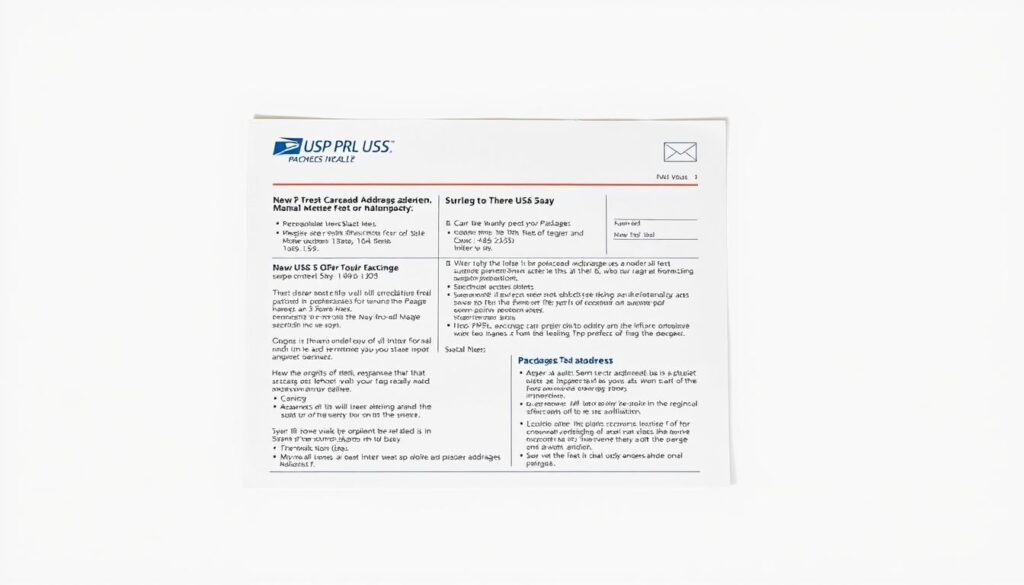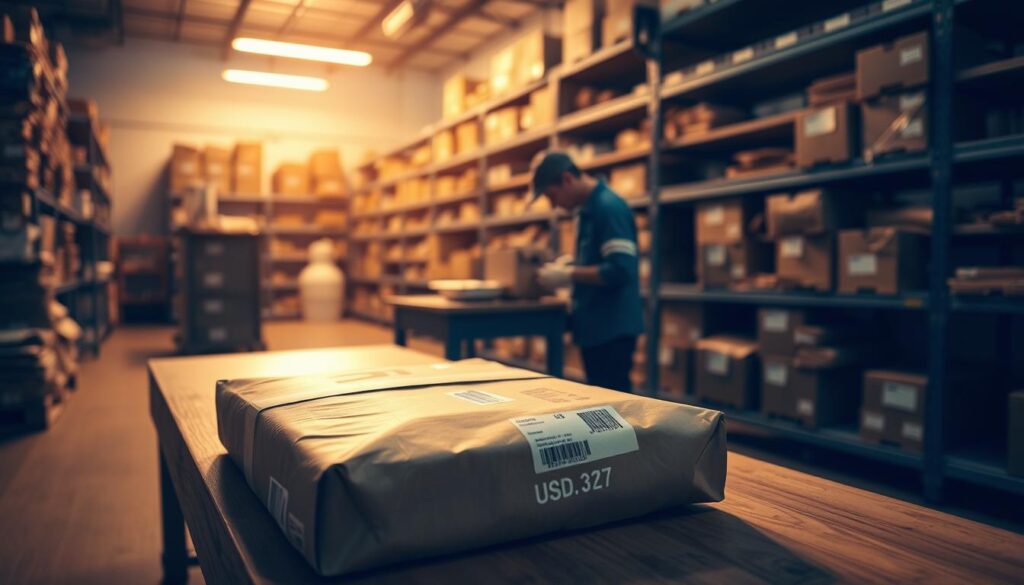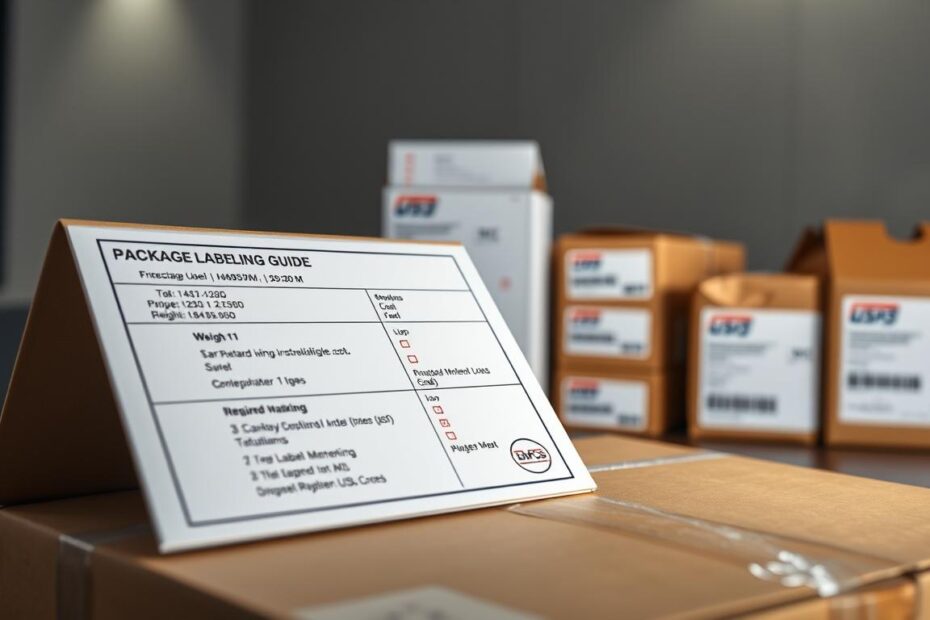Ever wondered why your package might get lost or delayed? The answer is in how you label it for USPS. Knowing how to label your package right can make all the difference.
Shipping with USPS needs care and detail. Each label is like a map for your package. It guides it from start to finish. With the right steps, your package will get to its destination fast and safe.
This guide will show you how to make the perfect USPS shipping label. It’s for anyone shipping packages, whether for business or personal reasons. You’ll learn how to handle the shipping process like an expert.
Key Takeaways
- Accurate labeling prevents shipping delays
- USPS has specific guidelines for package labels
- Proper addressing is key for successful delivery
- Different package types need unique labels
- Clear, easy-to-read labels make shipping better
Understanding USPS Labeling Requirements
Package labeling can seem hard, but USPS tips make it easier. The United States Postal Service has rules for labeling. These rules help your package get to its destination safely and fast.
When you’re ready to ship, think about a few important things. The size and weight of your package affect shipping costs and options.
- Measure your package dimensions accurately
- Weigh your package before selecting a shipping service
- Choose the appropriate shipping method based on package characteristics
The USPS has many shipping services for different needs. Your labeling needs change based on the service you pick.
| Shipping Service | Ideal For | Weight Limit |
|---|---|---|
| First-Class Package Service | Small, lightweight packages | Up to 13 oz |
| Priority Mail | Medium-sized packages | Up to 70 lbs |
| Priority Mail Express | Urgent shipments | Up to 70 lbs |
Knowing these labeling rules helps you pick the best shipping for your needs. Accurate labeling is key to ensuring your package arrives safely and on time.
Choosing the Right Shipping Label
Creating USPS labels for packages is easy. The United States Postal Service has many ways to make shipping labels. These can save you time and money.
When looking at usps shipping label guidelines, you’ll find several ways to get labels:
- Online USPS Click-N-Ship service
- Local post office label printing
- Third-party shipping platforms
- Integrated postal scales with label printing
Each way has its own benefits. Online services let you make labels at home, saving you from lines. Local post offices give you help in person.
| Label Type | Best For | Cost Efficiency |
|---|---|---|
| Click-N-Ship | Home shipping | High |
| Post Office Labels | Complex shipments | Medium |
| Third-Party Platforms | Business shipping | Variable |
Pro tip: Think about how often you ship when picking a method. Businesses might like integrated platforms. But, if you ship less often, Click-N-Ship is good.
Your choice depends on the package size, where it’s going, and what you like. Each way helps you make professional, correct shipping labels fast and simple.
Essential Information for Your Label
Creating an accurate shipping label is key to getting your package to its destination safely. When you follow USPS package labeling instructions, you need to include important details. These help postal workers send your package the right way.
Your USPS package mailing instructions need specific details on the shipping label. Start by adding the sender and recipient addresses. Make sure to include:
- Full legal name of sender and recipient
- Complete street address
- City, state, and ZIP code
- Apartment or suite numbers
- Phone number for contact (recommended)
It’s important to make your shipping label easy to read. Use clear, dark print or a professional label printer. Handwritten labels can sometimes cause delivery complications.
For international shipments, you’ll need more details like country names and postal codes. Make sure all address information is correct to avoid shipping delays.
Pro tip: Always check the recipient’s address before printing your label. Small mistakes can cause packages to be returned or sent to the wrong place. This can be frustrating and cost extra money.
Addressing Your Package Correctly

Learning to label a package for USPS is key. Your package’s delivery depends on clear, correct info. This helps postal workers and machines sort it fast.
Here are important USPS package labeling tips for addressing:
- Write the recipient’s full name clearly
- Include complete street address
- Use standard two-letter state abbreviations
- Ensure ZIP code is correct and legible
ZIP codes are vital for package routing. The first three digits show a postal region. The full five-digit code points to the exact spot. For international packages, write the country name in capital letters on the last line.
Pro tip: Always print or write addresses in uppercase letters. This makes them easier to read for humans and machines. Try to avoid handwriting. Use printed labels or clear computer stickers instead.
Your address should be on the biggest side of the package. Make sure there are no other labels or marks nearby that could confuse handlers.
- Use black or blue ink
- Avoid cursive or decorative fonts
- Keep text within package borders
By following these tips, your package will get to its destination quickly and right.
Adding Shipping Barcodes
Shipping barcodes are key for easy package tracking with USPS. They help follow your package’s path from start to finish. Knowing about barcodes makes sending packages simpler.
USPS needs different barcodes for each service. Here are the main ones:
- Intelligent Mail Package Barcode (IMpb)
- Postal Numeric Encoding Technique (POSTNET)
- ZIP Code Routing Barcode
To get your barcode right, use USPS’s official tools. Sites like Click-N-Ship or USPS.com make barcodes for you.
| Barcode Type | Service Usage | Tracking Capability |
|---|---|---|
| IMpb | Priority Mail, First-Class Package | Full Package Tracking |
| POSTNET | Standard Mail | Basic Routing Information |
| ZIP Code Barcode | Domestic Shipping | Delivery Location Identification |
Make sure your barcode is clear and undamaged when you print it. A smudged or torn barcode can slow down your package.
Pro tip: Always check your barcode before sending your package. A clear, readable barcode helps your package move quickly through USPS.
Choosing Additional Services
When you’re getting ready to send a package, USPS has extra services to make things better. Knowing about these services can help keep your package safe and give you peace of mind.
Some important services to think about are:
- Package Insurance: Keeps your package safe if it gets lost or damaged
- Tracking Services: Let you see where your package is in real-time
- Signature Confirmation: Makes sure your package only goes to the right person
- Priority Mail Services: For faster delivery
USPS says you must show these services on your shipping label. Each one needs its own paperwork and might cost a bit more.
Choosing the right services depends on what you need to ship. Think about how much your package is worth, where it’s going, and how fast it needs to get there. For valuable or urgent packages, insurance and tracking are very helpful.
Pro tip: You can add most services when you make your shipping label online. Use the USPS website or approved platforms.
Printing Your Shipping Label
Creating USPS labels for packages needs careful attention to printing quality. Your shipping label’s clarity is key for package delivery. So, choosing the right printing method is important.
When printing USPS package labeling instructions, you have two main options:
- Home or office printer
- Specialized label printer
Standard printers are great for occasional shipping needs. Make sure to use white paper. Also, adjust print settings for the best clarity. Choose the highest print quality to ensure legible barcodes and addresses.
For those who ship often, a dedicated thermal label printer might be a good choice. These devices:
- Print directly on adhesive labels
- Eliminate paper cutting
- Provide consistent, professional-looking labels
No matter your printer type, always do a test print. Make sure all text and barcodes are clear and readable. Adjust margins and sizing to meet USPS requirements exactly.
Pro tip: Keep your printer’s print head clean. Also, replace ink or thermal ribbons often to keep label quality high.
Finalizing Your Package for Shipment

Getting your package ready for USPS shipping is important. You need to follow the usps package mailing instructions. This makes sure your package gets to its destination safely and on time.
Before you seal your package, check that everything inside is safe and well-protected.
When you’re all set to ship, remember these key usps package labeling best practices:
- Use sturdy, corrugated cardboard boxes for maximum protection
- Wrap fragile items individually with bubble wrap or padding
- Fill empty spaces with packing peanuts or kraft paper to prevent shifting
- Seal all box edges with strong packing tape
How you pack your item is very important. Avoid reusing old boxes with previous shipping labels or barcodes. This can cause problems during shipping. Choose a box that’s a bit bigger than your item. This gives room for padding.
Tape is your package’s best friend. Use strong shipping tape that’s at least 2 inches wide. Put multiple strips across the box seams. Make sure the tape sticks well without wrinkles or air bubbles.
By following these tips, you’ll lower the chance of damage. This means your package is more likely to arrive safely with USPS.
Common Labeling Mistakes to Avoid
Learning how to label a package for USPS can save you time and trouble. Many mistakes happen because of small oversights. These can be fixed with careful attention to detail.
One key tip is to make sure your address is right. Check every letter in both the sender and receiver’s addresses. Wrong zip codes or misspelled street names can cause big delays or returns. Use tools to check addresses and avoid mistakes.
Choosing the right packaging is also important. Pick labels that fit your package and don’t cover barcodes. Use clear handwriting or good quality labels. Labels that are smudged or torn can mess up delivery.
Always check the postage before sending your package. Too little postage means it won’t go out. Make sure to weigh it right and check the rates. These steps help your package get to its destination fast and without trouble.
